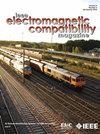An Efficient Surface Integral Equation-Method of Moments for Analysis of Electromagnetic Shielding Effectiveness of a Perforated Isotropic and Lossy Enclosure
IF 2
3区 计算机科学
Q3 ENGINEERING, ELECTRICAL & ELECTRONIC
IEEE Transactions on Electromagnetic Compatibility
Pub Date : 2024-11-08
DOI:10.1109/TEMC.2024.3486209
引用次数: 0
Abstract
In this article, we introduce an efficient method of moments (MoM) to evaluate the electromagnetic shielding effectiveness of a perforated, isotropic, and lossy enclosure. Initially, we delineate the various homogeneous regions within the enclosure. Utilizing the surface equivalence theorem, we replace the interfaces between adjacent regions with appropriate electric and magnetic current densities, adhering to boundary conditions. The resulting surface integral equations (SIEs) are then numerically solved for the unknown current densities using the Galerkin-MoM. This process involves the inversion of a block impedance matrix with relatively modest size and condition number in each block, achieved through a block-inversion technique that significantly reduces computational demands. Notably, there are no restrictions on the number, location, size, or shape of apertures. The method's efficiency and precision are substantiated by comparing the results from several case studies against those obtained using the existing methods in the literature and a commercially available SIE code. It is demonstrated that the shielding effectiveness is profoundly influenced by the operating frequency, loss tangent, wall thickness, and aperture size due to attenuation in the wall thickness, reflections at the wall surfaces, and multiple internal reflections.用于分析穿孔各向同性损耗围护结构电磁屏蔽效果的高效表面积分方程-矩量法
在本文中,我们介绍了一种有效的矩量法(MoM)来评估穿孔、各向同性和损耗外壳的电磁屏蔽效果。最初,我们描绘了圈地内的各种同质区域。利用表面等效定理,在符合边界条件的情况下,用合适的电流密度和电流密度替换相邻区域之间的界面。然后用伽辽金-矩法对未知电流密度的表面积分方程进行数值求解。该过程涉及到每块阻抗矩阵的相对适度的大小和条件数的反演,通过块反演技术实现,大大减少了计算需求。值得注意的是,对孔径的数量、位置、大小或形状没有限制。通过将几个案例研究的结果与使用文献中现有方法和市售SIE代码获得的结果进行比较,证实了该方法的效率和精度。结果表明,工作频率、损耗切线、壁厚和孔径大小对屏蔽效果有较大影响,这主要是由于壁厚衰减、壁面反射和多重内反射。
本文章由计算机程序翻译,如有差异,请以英文原文为准。
求助全文
约1分钟内获得全文
求助全文
来源期刊
CiteScore
4.80
自引率
19.00%
发文量
235
审稿时长
2.3 months
期刊介绍:
IEEE Transactions on Electromagnetic Compatibility publishes original and significant contributions related to all disciplines of electromagnetic compatibility (EMC) and relevant methods to predict, assess and prevent electromagnetic interference (EMI) and increase device/product immunity. The scope of the publication includes, but is not limited to Electromagnetic Environments; Interference Control; EMC and EMI Modeling; High Power Electromagnetics; EMC Standards, Methods of EMC Measurements; Computational Electromagnetics and Signal and Power Integrity, as applied or directly related to Electromagnetic Compatibility problems; Transmission Lines; Electrostatic Discharge and Lightning Effects; EMC in Wireless and Optical Technologies; EMC in Printed Circuit Board and System Design.

 求助内容:
求助内容: 应助结果提醒方式:
应助结果提醒方式:


